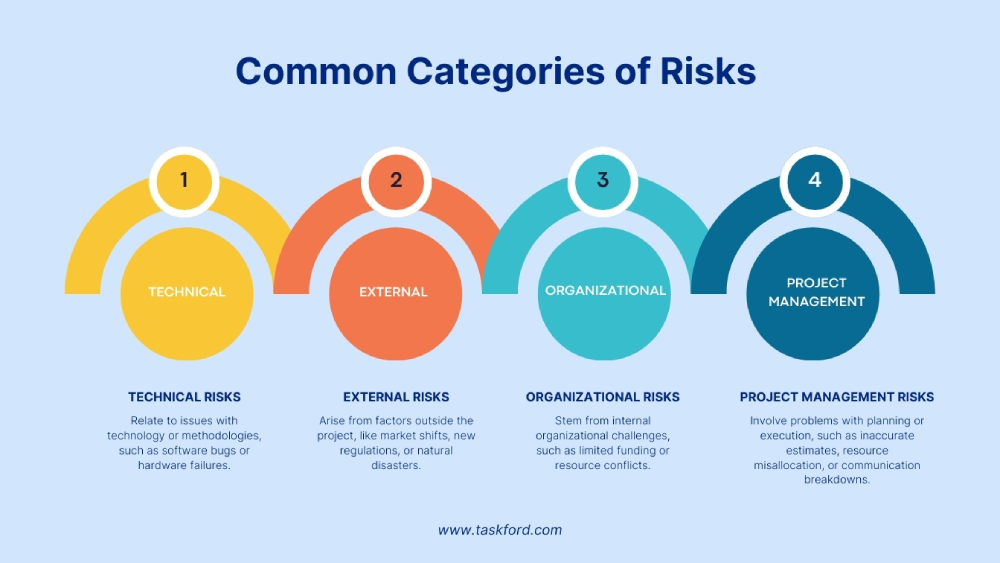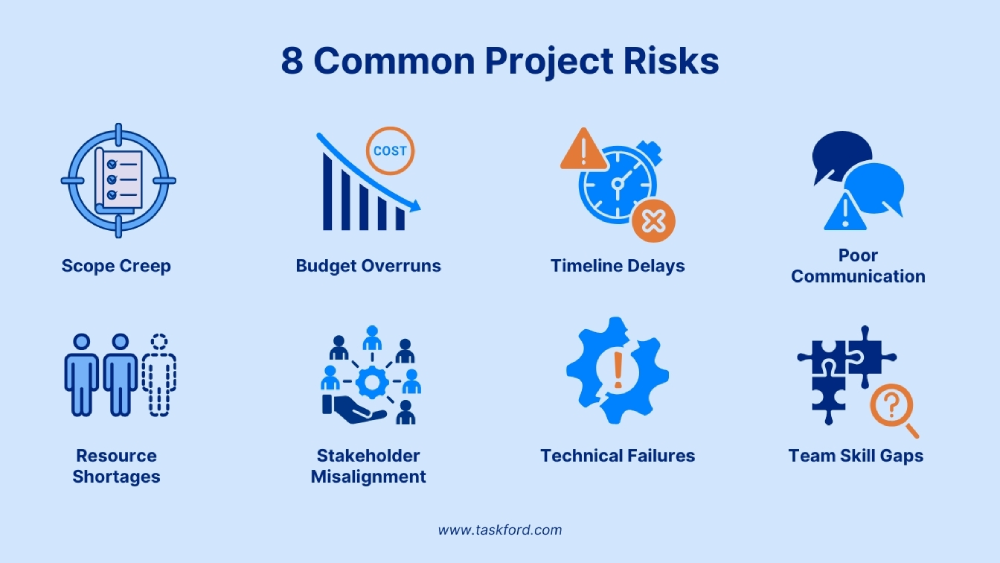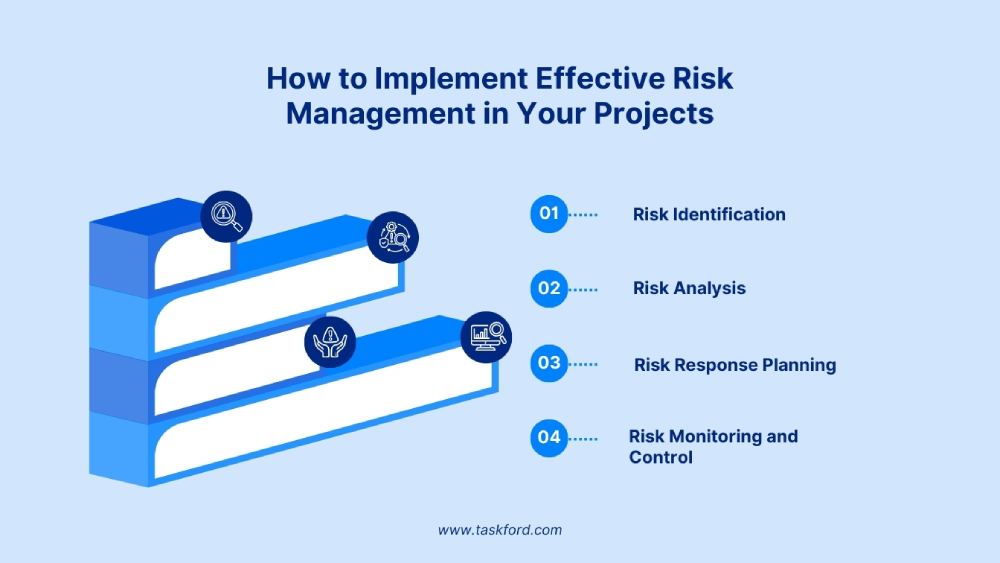8 Common Project Risks and How to Safeguard Against Them
Learn about common project risks and strategies to manage them effectively, ensuring your project stays on track, on budget, and on time.
Project risks are an inevitable part of any project, from budget overruns to missed deadlines. These risks can disrupt progress and prevent projects from achieving their goals. However, understanding and managing project risks effectively can minimize their impact and help keep things on track.
In this article, we’ll explore common project risks and share strategies for identifying and mitigating them. By actively managing project risks, you can ensure your project stays within budget, meets its deadlines, and delivers high-quality results. Whether you’re an experienced project manager or new to the field, mastering project risk management is key to success.
Project Risks: What Are They?
Project risks are potential events or conditions that could negatively affect a project’s ability to meet its objectives. These risks can arise from various factors such as external circumstances, internal issues, or unforeseen challenges. Essentially, project risks introduce uncertainty into the project, and if not properly managed, they can lead to delays, increased costs, or compromised quality.
Risks can be categorized in several ways, but a common approach is to group them by the area they affect.
- Technical Risks: These are related to the technology or methodology being used. Examples include software bugs, hardware failures, or the inability to achieve a desired level of performance.
- External Risks: These risks come from outside the project itself and are often beyond the project team’s control. Examples include changes in market conditions, new government regulations, or natural disasters.
- Organizational Risks: These are tied to the organization’s resources, structure, and processes. Examples include a lack of funding, competing projects for the same resources, or an inability to get timely decisions from management.
- Project Management Risks: These relate to the project’s planning and execution. Examples include poor estimates, improper resource allocation, or a failure to communicate effectively with stakeholders.

To explore more types of risks in detail, check out our guide on 7 Common Types of Risks in Project Management Every Manager Should Know, and gain a deeper understanding of how to manage them effectively.
Why Understanding and Preventing Risks is Crucial
Understanding and preventing risks is crucial because it allows you to proactively manage a project’s future instead of just reacting to problems as they happen. This foresight helps you protect your budget and schedule, avoid costly delays, and make more informed decisions.
By identifying potential threats early, you can maintain a high-quality final product and build greater confidence with all project stakeholders. Ultimately, it’s the difference between a project that’s on track and one that’s constantly scrambling to catch up.
8 Common Project Risks and How to Avoid Them

1. Scope Creep
Scope creep is the uncontrolled expansion of a project’s requirements without adjusting the schedule, budget, or resources. This often happens when stakeholders request new features after the project has started.
How to avoid scope creep:
- Establish a formal change control process from the beginning.
- Clearly define the project’s scope in a detailed Statement of Work (SOW) and obtain formal sign-off from all stakeholders.
- Ensure that all new requests go through a review process to assess their impact on the timeline, budget, and resources before approval.
2. Budget Overruns
This risk occurs when the project’s actual costs exceed the amount that was originally allocated. It’s often caused by inaccurate initial estimates, poor cost control, or unexpected expenses, which can halt a project or force a reduction in its scope.
How to avoid budget overruns:
- Conduct thorough and realistic cost estimates, using historical data from similar projects.
- Always include a contingency reserve – typically 5-10% of the total budget – to cover unexpected costs. Regularly monitor expenses and track them against the budget to identify deviations early.
3. Timeline Delays
Timeline delays happen when the project does not meet its scheduled milestones or final deadlines. Delays can arise from several factors, including unexpected challenges, resource shortages, or changes in the project scope.
How to avoid timeline delays:
- Create a detailed and realistic project schedule, breaking large tasks into manageable subtasks.
- Use project management tools like Gantt Charts to visualize the timeline and identify Dependencies.
- Involve the team in the estimation process to ensure buy-in and improve the accuracy of deadlines.
4. Poor Communication
Poor communication within a project team or between stakeholders can lead to misunderstandings, missed deadlines, or mistakes in the project’s deliverables.
How to avoid poor communication:
- Develop a project communication plan outlining who needs information, how often, and through which channels.
- Hold regular, structured meetings to keep everyone aligned.
- Use a centralized platform like TaskFord for all project-related communication, ensuring everyone has access to the latest updates.
5. Resource Shortages
Resource shortages refer to situations where the project does not have enough of the necessary resources, whether human, financial, or technological, to successfully complete tasks on time.
How to avoid resource shortages:
- Perform detailed resource planning during the initial project phase, identifying all required resources and their availability.
- If any resources are in limited supply, have a backup plan or alternate sources ready to avoid delays.
6. Stakeholder Misalignment
Stakeholder misalignment happens when key stakeholders (e.g., clients, team members, or sponsors) have conflicting expectations or goals for the project.
How to avoid stakeholder misalignment:
- Identify all stakeholders early in the project.
- Create a clear project charter outlining the project’s vision, goals, and success metrics.
- Obtain formal agreement and alignment from all stakeholders before beginning any work.
7. Technical Failures
Technical failures occur when the technology or systems used in the project do not function as expected or fail to meet performance requirements, leading to delays, errors, or defects.
How to avoid technical failures:
- Conduct a thorough technical feasibility study before starting the project to ensure the technology is reliable.
- Use proven technologies whenever possible.
- If relying on new or untested technology, conduct early testing and create contingency plans to address potential issues.
8. Team Skill Gaps
Skill gaps occur when project team members lack the necessary skills or knowledge to complete specific tasks, leading to inefficiencies, errors, or delays.
How to avoid team skill gaps:
- Conduct a skills assessment of the team before the project begins to identify any gaps.
- Address skill gaps through targeted training, hiring new personnel, or outsourcing specialized tasks to third-party experts.
By understanding these common project risks and proactively implementing strategies to address them, you can significantly reduce their impact on your project. Effective risk management ensures that your project stays on track, within budget, and delivers the desired results.
How to Implement Effective Risk Management in Your Projects
Implementing effective risk management is a proactive and systematic process that helps a project stay on track. It’s not a one-time event, but a continuous cycle that starts at the beginning of a project and continues until its completion.

Here are the key steps to implement effective risk management:
1. Risk Identification
This is the first and most critical step: finding all potential risks. A comprehensive list of risks allows you to be prepared for what might go wrong.
How to identify risks:
- Brainstorming: Gather your project team and key stakeholders to openly discuss potential risks, both positive and negative, that could affect the project.
- Checklists: Use checklists of common risks from past projects or industry standards to ensure you don’t overlook anything.
- Expert Interviews: Consult with experienced project managers or subject matter experts to leverage their knowledge from similar projects.
- Assumptions Analysis: Review project assumptions, as any false assumptions can quickly turn into significant risks.
2. Risk Analysis
Once risks are identified, they need to be evaluated to determine their potential impact. This helps you prioritize which risks need the most attention.
- Qualitative Analysis: This involves ranking risks based on their probability (how likely they are to occur) and their impact (the severity of the effect if they do occur). A simple 5x5 matrix is often used to categorize risks as high, medium, or low priority.
- Quantitative Analysis (for major projects): For larger projects, you can use numerical data to assess risks. This might involve tools like a Monte Carlo simulation to estimate the probability of the project meeting cost and schedule objectives.
To understand how to better prioritize and assess risks using a Risk Assessment Matrix, check out our detailed guide for a step-by-step approach.
3. Risk Response Planning
After analyzing and prioritizing risks, you must develop a plan for how to handle each one. There are four main strategies:
- Avoid: Change the project plan to eliminate the risk entirely. For example, if a new technology poses a high risk, you might choose to use a more proven technology instead.
- Mitigate: Take steps to reduce the probability or impact of the risk. If a team member leaving is a risk, a mitigation strategy could be cross-training team members on key tasks.
- Accept: Acknowledge the risk but decide to take no action. This is usually done for low-priority risks where the potential impact is minor and the cost of managing it is too high.
- Transfer: Shift the responsibility for the risk to a third party. This is often done through insurance, warranties, or by outsourcing a specific part of the project to a specialized vendor.
4. Risk Monitoring and Control
Risk management is an ongoing process. Throughout the project, you must continuously monitor the identified risks and look for new ones.
- Assign Risk Owners: For each high-priority risk, assign a specific team member to monitor it and be responsible for implementing the response plan if it occurs.
- Regular Review: Hold regular meetings to review the risk register, which is a document that tracks all identified risks, their analysis, and their response plans.
- Implement Response Plans: If a risk becomes a reality (an “issue”), the designated risk owner must immediately put the pre-planned response into action.
By following these steps, you embed a proactive culture into your project, making it more resilient to the unexpected and significantly increasing its chances of success.
Conclusion
Effectively managing project risks isn’t about eliminating all potential problems—it’s about being prepared for them. By proactively identifying, analyzing, and developing response plans for common risks like scope creep or budget overruns, you can significantly reduce their negative impact. The core of effective risk management lies in its continuous nature: it’s a cycle of monitoring and adapting, not a one-time task. Ultimately, mastering this process gives you a powerful tool to protect your project’s schedule, budget, and quality, ensuring that you consistently deliver successful results and build stakeholder confidence.
Continue Reading
- How AI Can Help You Spot Project Risks Early - Predict Before You Panic.
- Enterprise Risk Management (ERM) - What It Means and How It Works
- Contingency Planning in Project Management - How to Stay on Track When Things Don’t Go as Planned
Subscribe for Expert Tips
Unlock expert insights and stay ahead with TaskFord. Sign up now to receive valuable tips, strategies, and updates directly in your inbox.